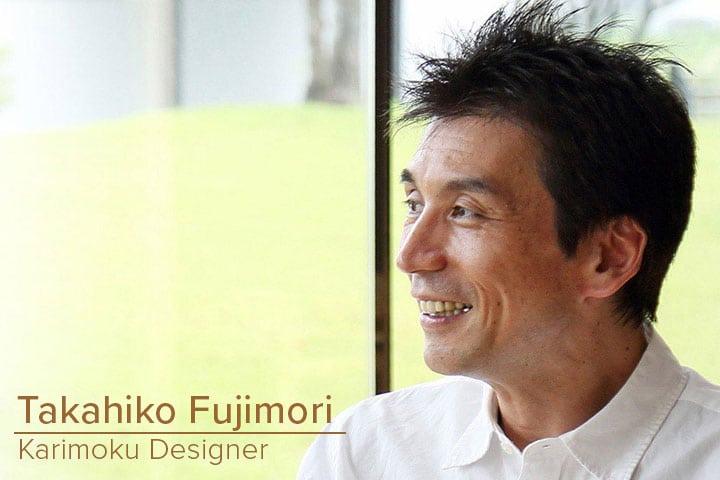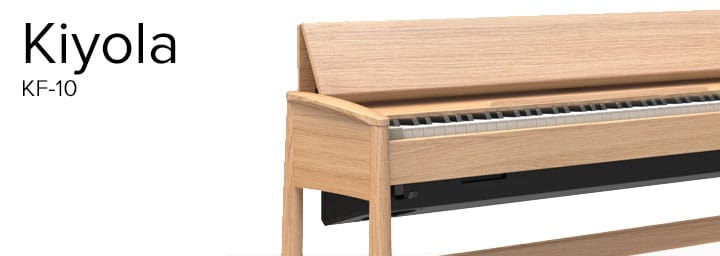Synergy – Beautiful design meets audio excellence
The KIYOLA designer piano was created by a unique collaboration of two companies from different industries.
Roland, an electronic music instrument maker and furniture designer Karimoku – a furniture maker known for its deep understanding and love of timber.
Karimoku’s goal was to create a piano that ‘harmonised’ with the home interiors. Also, one that the player feels a connection with.
Kiyola – designer piano
Our interviews focus on the key people involved in the development of KIYOLA. Here, they show the passion that they have for their products.
We interviewed Takahiko Fujimori from Karimoku, who designed KIYOLA KF-10.
Karimoku – A Furniture Maker with a Thorough Knowledge and love of Wood.
Contributed by Roland Japan
Recommended Article: INTRODUCING THE KIYOLA VOL. 2 – HOW ROLAND AND KARIMOKU CARVED A NEW PIANO

Customers seek “Genuine”
– Could you tell us about yourself, Mr Fujimori?
Fujimori: I worked for a design company after I finished my post-graduate degree at University and joined Karimoku in 1997. Currently, I am a designer in the Development Department.
– What kind of products do you design at Karimoku?
Fujimori: I design and develop sofas, tables and dining sets for home interiors. I was involved in the design of some of the furniture that surrounds the KIYOLA products in the Karimoku showroom.

The inspired use of natural materials
– Furniture designed by Mr Fujimori feature the natural materials of timber. They compliment the textures of the home’s interior space. It seems that more people these days prefer items or designs that focus on the natural materials used. From your standpoint as a designer, what do you think of this?
Fujimori: Trends in the furniture market depends on categories and the customer generation. But when we talk about timber furniture, I feel that products are now required to finish up highlighting the original materials. This includes the remarkable aspects of timber, such as bur, unique colour, and pattern.
Natural materials like timber and stone are actively used in architecture as well. I think people have started looking for a more definite sense of materials in furniture. We see more ‘rustic’ renovated spaces becoming popular.

An evolving marketplace
Consumers have more information and knowledge about interiors now. Total coordination of the home interior is important like never before.. This includes the beauty or usefulness of a single item of furniture – so we see their quest for genuine designs based on their own passion.

‘If we use a 100 year old tree, we want to respect that and make appropriate furniture.’
– Furniture you design gives a sense of warmth and caring, even though they are simple. What kind of passion drives these products?
Fujimori: I try to create furniture that people will love long into the future. I have a passion to maximise the beautiful character of timber. There are a lot of enduring products in the furniture/interior category, in contrast to electronic appliances which always evolve and change.
The importance of tradition
For instance, in our Karimoku 60 brand, there are many products which haven’t changed. They have been loved for more than half a century since they were born. Our goal is to create great products which are loved for a long time, even if lifestyle or market trends change. This is difficult to achieve. We are working with KIYOLA to project the same goal and passion.

Other passions?
The way we utilise the materials is another passion. Oak (which is used by KIYOLA as well), is grown in northern areas like Hokkaido in cold, tough conditions. These trees take a few years to grow as big as a little finger, and it takes some decades until they can be used as timber.
When I visited a forest in Hokkaido, where they were planning the planting and trimming. Seeing a connection between people and forest based on a cycle of decades, I saw how small parts can be taken from big trees and used for timber.
I did feel how precious these woods are as a material. When I design furniture, I try not to rely on the existence of large materials but rather choose appropriate material and take advantage of its nature.

What about changing trends?
– You talked about furniture which will be loved for a long time, even through changing trends. In designing KIYOLA, what did you value most ?
Fujimori: Based on the brand’s theme, “pianos that fit the life of an interior”, we wanted to create in KIYOLA a certain presence through the warmth and richness of timber.
How was this achieved?
To achieve this, we have tried to create the lightness of timber framing (such as in Northern European timber chairs. We have also tried to retain the soft details that timber materials have. Finally, we created a piano that we can call ‘interior’ with high performance, but with compact equipment and discrete speaker layouts.

What were the challenges?
– Furniture and electric pianos have very different elements, so I imagine it was a difficult job to create such a piano. Were there any memorable events?
Fujimori: There was one memorable event in the development process. Initially, we were told that the piano components would be compact, so we started designing based on that. But one day when we made a test product, we had contact from Roland and were told that they wanted to upgrade the components.
Elegant solutions
We expected that the size of the keyboard’s electric devices and total piano size would be larger, so we thought we had to change the style. Fortunately, the new components from Roland were high-density and compact, which was a pleasant suprise.. Against the odds, we didn’t need to change the style a lot in the end.
I imagine the staff in the Development Unit at Roland tried very hard not to change the original design. I felt their strong passion on our new project together.

Life with KIYOLA designer piano
– If you had KIYOLA at your place, how would you want the layout? Are there any tips you have for the layout?
Fujimori: Usually, you see a piano player from their back. If you keep KIYOLA by the window and open the blind for example, you can see the player’s figure and facial expressions, which must be nice to see.
This is just one example of how to utilise KIYOLA’s feature of not blocking space, because of it’s thin style. Another example, if you keep KIYOLA behind a sofa chair, you can see the player from the front and listen to the sound up close while relaxing.

What about colour for the kiyola piano?
– Colour is also a very important factor for a customer to choose, as well as shape. Could you tell us about the three colours* in the KIYOLA range and their good points and features?
Fujimori: We have three colours as would be expected with a designer piano They are all very close to the original timber, so you can really enjoy the natural and enduring qualities that timber offers. With Pure Oak, you can really feel the direct texture of natural oak. Sheer White features white oak and would suit various interiors and is easy to co-ordinate with other items of varying colours. Walnut has a chic and mature quality and is popular worldwide as a high quality timber.
*Colour variation varies on each country. We have 4 colours (Sheer Black, Pure Oak, Sheer White and Walnut) available in Australia.

Any final words?
– And last, could you tell us your ideas or passion for creating a designer piano or even another instrument?
Fujimori: I want to deepen the KIYOLA project and try to remove the boundary between timber furniture and the piano. If I can find an idea to create something that makes people happy, something you can play in a living space, then I think it will open up new possibilities.
In conclusion
I hope KIYOLA becomes a piano not just for a single player, but for a whole family. Something that looks like a table you might share with your family, but when you open it up you can play music.
It would be great if you could create a space naturally where family or friends who may never have touched a piano are drawn to play it. For example, a wife who can play the piano might teach her husband. And then they play together – it means they can create happy times.
– Thank you

